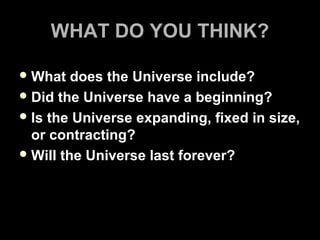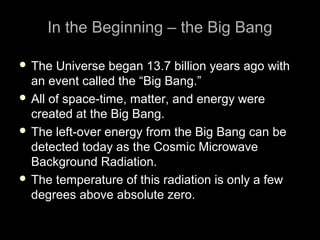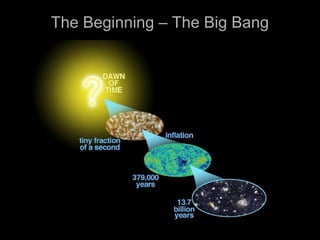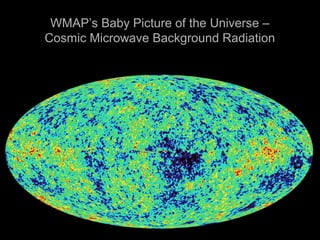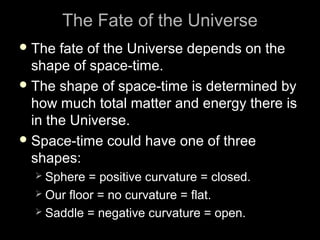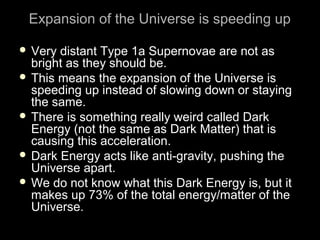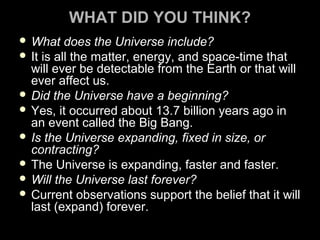16 cosmology
- 1. Chapter 18:Chapter 18: Cosmology
- 2. WHAT DO YOU THINK? What does the Universe include? Did the Universe have a beginning? Is the Universe expanding, fixed in size, or contracting? Will the Universe last forever?
- 3. You will discover…You will discover… Cosmology, which seeks to explain how the Universe began, how it evolves, and its fate. The best theory we have for the evolution of the Universe – the Big Bang. How astronomers explain the overall structure of the Universe. Our understanding of the fate of the Universe.
- 4. In the Beginning – the Big BangIn the Beginning – the Big Bang The Universe began 13.7 billion years ago withThe Universe began 13.7 billion years ago with an event called the “Big Bang.”an event called the “Big Bang.” All of space-time, matter, and energy wereAll of space-time, matter, and energy were created at the Big Bang.created at the Big Bang. The left-over energy from the Big Bang can beThe left-over energy from the Big Bang can be detected today as the Cosmic Microwavedetected today as the Cosmic Microwave Background Radiation.Background Radiation. The temperature of this radiation is only a fewThe temperature of this radiation is only a few degrees above absolute zero.degrees above absolute zero.
- 5. The Beginning – The Big BangThe Beginning – The Big Bang
- 6. In Search of The Earliest PhotonsIn Search of The Earliest Photons Wilkinson Microwave Anisotropy Probe (WMAP) satellite, launched in 2001
- 7. WMAP’s Baby Picture of the Universe –WMAP’s Baby Picture of the Universe – Cosmic Microwave Background RadiationCosmic Microwave Background Radiation
- 8. The Universe is ExpandingThe Universe is Expanding The Redshift of Superclusters shows usThe Redshift of Superclusters shows us that the Universe is expanding. Thisthat the Universe is expanding. This Redshift is called the “Redshift is called the “CosmologicalCosmological RedshiftRedshift,” because it is,” because it is caused by thecaused by the expansion of spaceexpansion of space.. TheThe farther awayfarther away a galaxy is from us, thea galaxy is from us, the faster it movesfaster it moves away from us.away from us.
- 9. The Expansion of the Universe –The Expansion of the Universe – Cosmological RedshiftCosmological Redshift Space itself is expanding.
- 10. Expanding Cake AnalogyExpanding Cake Analogy Just as all the chocolate chips move apart as the cake rises, all the superclusters of galaxies move away from each other as the space of the Universe expands.
- 11. The Observable UniverseThe Observable Universe The cosmic light horizon today is about 13.7 billion light-years away in all directions.
- 12. HST – Galaxies >13 Billion LY AwayHST – Galaxies >13 Billion LY Away This HST Ultra Deep Field Telescope image shows some of the most distant galaxies we have seen.
- 13. Early Universe Temperature VariationsEarly Universe Temperature Variations Tiny temperature fluctuations in the Cosmic Microwave Background Radiation are related to the large-scale structure of the Universe today, indicating where Superclusters and voids grew.
- 14. The First Stars – much larger than the Sun –The First Stars – much larger than the Sun – with much shorter liveswith much shorter lives The burst of star formation that occurred within a few hundred million years after the Big Bang.
- 15. Proto-Galaxy FormationProto-Galaxy Formation Hubble and Keck telescope images of two groups of stars that are believed to be proto-galaxies, from which bigger galaxies grew
- 16. Creation of Spiral and Elliptical GalaxiesCreation of Spiral and Elliptical Galaxies A galaxy begins as a huge cloud of primordial gas that collapses gravitationally. If the rate of star formation was low, then a spiral galaxy formed. If the rate of star formation was high, then an elliptical galaxy formed.
- 17. The Fate of the UniverseThe Fate of the Universe The fate of the Universe depends on theThe fate of the Universe depends on the shape of space-time.shape of space-time. The shape of space-time is determined byThe shape of space-time is determined by how much total matter and energy there ishow much total matter and energy there is in the Universe.in the Universe. Space-time could have one of threeSpace-time could have one of three shapes:shapes: Sphere = positive curvature = closed.Sphere = positive curvature = closed. Our floor = no curvature = flat.Our floor = no curvature = flat. Saddle = negative curvature = open.Saddle = negative curvature = open.
- 18. Possible Shapes of Space-time,Possible Shapes of Space-time, and the Fate of the Universeand the Fate of the Universe • Closed –Closed – UniverseUniverse wouldwould collapse.collapse. • Flat –Flat – UniverseUniverse could slowlycould slowly expandexpand forever.forever. • Open –Open – UniverseUniverse wouldwould expandexpand forever.forever.
- 19. Cosmic Microwave Background indicates that Space-Cosmic Microwave Background indicates that Space- time is Flat – Universe could slowly expand forevertime is Flat – Universe could slowly expand forever
- 20. BUT – dimmer distant Supernovae mean theBUT – dimmer distant Supernovae mean the expansion of the Universe is speeding up.expansion of the Universe is speeding up.
- 21. 100 billion years from now the Universe will appear frozen in time as we look out into space. Only the light from the Local Group of galaxies will remain visible, if anyone is still around to see it.
- 22. Expansion of the Universe is speeding upExpansion of the Universe is speeding up Very distant Type 1a Supernovae are not asVery distant Type 1a Supernovae are not as bright as they should be.bright as they should be. This means the expansion of the Universe isThis means the expansion of the Universe is speeding up instead of slowing down or stayingspeeding up instead of slowing down or staying the same.the same. There is something really weird called DarkThere is something really weird called Dark Energy (not the same as Dark Matter) that isEnergy (not the same as Dark Matter) that is causing this acceleration.causing this acceleration. Dark Energy acts like anti-gravity, pushing theDark Energy acts like anti-gravity, pushing the Universe apart.Universe apart. We do not know what this Dark Energy is, but itWe do not know what this Dark Energy is, but it makes up 73% of the total energy/matter of themakes up 73% of the total energy/matter of the Universe.Universe.
- 23. Composition of the UniverseComposition of the Universe Suppose all the matter and energy in the Universe isSuppose all the matter and energy in the Universe is $100 in your wallet or purse.$100 in your wallet or purse. $73 would be$73 would be Dark EnergyDark Energy – the mysterious energy– the mysterious energy that’s pushing the Universe apart faster and faster.that’s pushing the Universe apart faster and faster. $23 would be$23 would be Dark MatterDark Matter – matter that doesn’t give off– matter that doesn’t give off any kind of radiation, so we can’t see it – but it doesany kind of radiation, so we can’t see it – but it does have gravity.have gravity. So out of your Universe of $100, $96 represents DarkSo out of your Universe of $100, $96 represents Dark Energy and Dark Matter that have yet to be identified.Energy and Dark Matter that have yet to be identified. Only $4 would beOnly $4 would be visible mattervisible matter – the regular stuff we– the regular stuff we can see, like stars, gas clouds, and dust – the same stuffcan see, like stars, gas clouds, and dust – the same stuff we’re made of.we’re made of. Of the visible matter ($4), only one-tenth of it shines asOf the visible matter ($4), only one-tenth of it shines as stars. That’s 40 cents out of your total $100. The rest ofstars. That’s 40 cents out of your total $100. The rest of the visible matter is gas clouds and dust.the visible matter is gas clouds and dust.
- 24. Composition of the UniverseComposition of the Universe Dark Energy (73%) Dark Matter (23%) Visible Matter except Stars (3.6%) Stars (0.4%)
- 25. WHAT DID YOU THINK? What does the Universe include? It is all the matter, energy, and space-time that will ever be detectable from the Earth or that will ever affect us. Did the Universe have a beginning? Yes, it occurred about 13.7 billion years ago in an event called the Big Bang. Is the Universe expanding, fixed in size, or contracting? The Universe is expanding, faster and faster. Will the Universe last forever? Current observations support the belief that it will last (expand) forever.
Editor's Notes
- For a humorous approach to quarks, check out the Jefferson Lab’s game. In Looking for the Top Quark, each player receives six quarks that they hide on a grid. The players use coordinates to find their opponent's hidden quarks. The first player to find all six of their opponent's quarks wins! education.jlab.org/topquarkgame/ Information on the Planck mission will be found at www.esa.int/science/planck.
- FIGURE 18-3 In Search of Primordial Photons (a) The Wilkinson Microwave Anisotropy Probe (WMAP) satellite, launched in 2001, improved upon the measurements of the spectrum and angular distribution of the cosmic microwave background taken by the COBE satellite. (b) The balloon-carried telescope BOOMERANG orbited above Antarctica for 10 days collecting data used to resolve the cosmic microwave background with 10 times higher resolution than that of COBE. All these experiments found local temperature variations across the sky, but no overall deviation from a perfect blackbody spectrum. (a: NASA/WMAP Science Team b: The BOOMERANG Group, University of California, Santa Barbara)
- FIGURE 18-1 Cosmological Redshift Just as the waves drawn on this rubber band are stretched along with the rubber band, so too are the wavelengths of photons stretched as the universe expands.
- The Expanding Chocolate Chip Cake Analogy The expanding universe can be compared to a chocolate chip cake baking and expanding in the Space Shuttle’s microwave oven. Just as all the chocolate chips move apart as the cake rises, all the superclusters of galaxies recede from each other as the universe expands.
- FIGURE 18-14 The Observable Universe This diagram shows why we only see part of the entire universe. As time passes, this volume grows, meaning that light from more distant galaxies reaches us. The galaxies we see at the farthest reaches of our telescopes’ resolving power are as they were within a few hundred million years after the Big Bang (see inset). These galaxies, formed at the same time as the Milky Way, appear young because the light from their beginnings is just now reaching us. The radius of the cosmic light horizon is equal to the distance that light has traveled since the Big Bang. Because the Big Bang occurred about 13.8 billion years ago, the cosmic light horizon today is about 13.8 billion light-years away in all directions. Inset: This image of the Hubble Deep Field shows some of the most distant galaxies we have seen. (inset: Robert Williams and the Hubble Deep Field Team, STScI and NASA)
- FIGURE 16-32 Distant Galaxies (a) The young cluster of galaxies MS1054-03, shown on the left, contains many orbiting pairs of galaxies, as well as remnants of recent galaxy collisions. Several of these systems are shown at the right. This cluster is located 8 billion light-years away from Earth. (b) This image of more than 300 spiral, elliptical, and irregular galaxies contains several that are an estimated 12 billion light-years from Earth. Two of the most distant galaxies are shown in the images on the right, colored in red at the centers of the pictures. (a, b: P. Van Dokkum, Uner of Granengen, ESA and NASA)
- FIGURE 18-15 Structure of the Early Universe This microwave map of the entire sky, produced from data taken by the Wilkinson Microwave Anisotropy Probe (WMAP), shows temperature variations in the cosmic microwave background. Red regions are about 0.00003 K warmer than the average temperature of 2.73 K; blue regions are about 0.00003 K cooler than the average. Inset: These tiny temperature fluctuations, observed by BOOMERANG, are related to the large-scale structure of the universe today, indicating where superclusters and voids grew. The radiation detected to make this map is from a time 379,000 years after the Big Bang. (NASA/WMAP Science Team; inset: NSF/NASA)
- FIGURE 18-16 Galaxies Forming by Combining Smaller Units (a) This painting indicates how astronomers visualize the burst of star formation that occurred within a few hundred million years after the Big Bang. The arcs and irregular circles represent interstellar gas that is illuminated by supernovae. (b) Using the Hubble and Keck telescopes, astronomers discovered two groups of stars (arrows) 13.4 Bly away that are believed to be protogalaxies, from which bigger galaxies grew. These protogalaxies were discovered because they were enlarged by the gravitational lensing of an intervening cluster of galaxies. (c) The Chandra X-ray telescope imaged gravitationally bound gas around the distant galaxy 3C 294. The X-ray emission from this gas is the signature of an extremely massive cluster of galaxies, in this case at a distance of about 11.2 Bly from us. (a: Adolf Schaller, STScI/NASA/K. Lanzetta, SUNY; b: Richard Ellis (Caltech) and Jean-Paul Kneib (Observatorie Midi- Pyrenees, France), NASA, ESA; c: NASA)
- FIGURE 18-16 Galaxies Forming by Combining Smaller Units (a) This painting indicates how astronomers visualize the burst of star formation that occurred within a few hundred million years after the Big Bang. The arcs and irregular circles represent interstellar gas that is illuminated by supernovae. (b) Using the Hubble and Keck telescopes, astronomers discovered two groups of stars (arrows) 13.4 Bly away that are believed to be protogalaxies, from which bigger galaxies grew. These protogalaxies were discovered because they were enlarged by the gravitational lensing of an intervening cluster of galaxies. (c) The Chandra X-ray telescope imaged gravitationally bound gas around the distant galaxy 3C 294. The X-ray emission from this gas is the signature of an extremely massive cluster of galaxies, in this case at a distance of about 11.2 Bly from us. (a: Adolf Schaller, STScI/NASA/K. Lanzetta, SUNY; b: Richard Ellis (Caltech) and Jean-Paul Kneib (Observatorie Midi- Pyrenees, France), NASA, ESA; c: NASA)
- FIGURE 18-18 The Creation of Spiral and Elliptical Galaxies A galaxy begins as a huge cloud of primordial gas that collapses gravitationally. (a) If the rate of star birth is low, then much of the gas collapses to form a disk, and a spiral galaxy is created. (b) If the rate of star birth is high, then the gas is converted into stars before a disk can form, resulting in an elliptical galaxy.
- FIGURE 18-20 The Possible Geometries of the Universe The shape of space (represented here as two-dimensional for ease of visualization) is determined by the matter and energy contained in the universe. The curvature is either (a) positive, (b) zero, or (c) negative, depending on whether the average matter and energy density throughout space is greater than, equal to, or less than a critical value. The lines on each curve are initially parallel. They converge, remain parallel, or diverge depending on the curvature of space.
- FIGURE 18-21 The Cosmic Microwave Background and the Curvature of Space Temperature variations in the early universe appear as “hot spots” in the cosmic microwave background. The apparent sizes of these spots depend on the curvature of space. (a) In a closed universe with positive curvature, light rays from opposite sides of a hot spot bend toward each other. Hence, the hot spot appears larger than it actually is, as shown by the dashed lines. (b) The light rays do not bend in a flat universe. (c) In an open universe, light rays bend apart. The dashed lines show that a hot spot would appear smaller than its actual size. (The BOOMERANG Group, University of California, Santa Barbara)
- FIGURE 18-22 Dimmer Distant Supernova (a) These Hubble Space Telescope images show the galaxy in which the supernova SN 1997ff occurred. This supernova, more than 10 Bly away, was dimmer than expected, indicating that the distance to it is greater than the distance it would have if the universe had been continually slowing down since the Big Bang. This supports the notion that an outward (cosmological) force is acting over vast distances in the universe. The arrow on the first inset shows the galaxy in which the supernova was discovered. The bright spot on the second inset shows the supernova by subtracting the constant light emitted by all the other nearby objects. (b) The distances and brightnesses of many very distant supernovae are plotted on this diagram. The location of the most distant supernovae in the upper region strongly indicates that the universe has been accelerating outward for the past 6 billion years. (a: Adam Riess, Space Telescope Science Institute, NASA)

